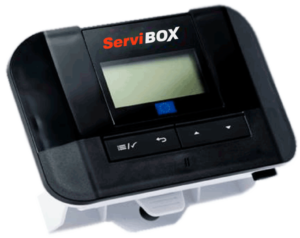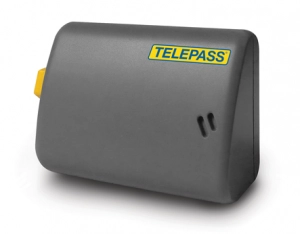For transporters, knowing the details of the toll system in Italy is essential for efficient and economical route planning. This article offers a comprehensive guide to tolls in Italy, focusing on trucks and heavy vehicles used in the transport of goods.
Who must pay tolls in Italy?
In Italy, all motor vehicles, including trucks, buses and light vehicles, must pay tolls to use the highways. Trucks traveling on the 6,600 km of highways (autostrade) are subject to paying tolls, which are calculated in two different ways:
- Closed sections: Here, the toll is charged based on the distance traveled. When entering the highway, you collect a ticket and when exiting, you pay according to the kilometers traveled.
- Open sections: On these sections, the toll is a fixed amount for each category of vehicle, regardless of the distance traveled.
The highways (strada extraurbana principale or “superstrada”), on the other hand, are free. However, in the case of certain specific areas such as the Strait of Messina and the Milan urban toll (Area C), the use of an electronic device is required for both light and heavy vehicles.
Types of tolls in Italy
In Italy, tolls operate by radio frequency and, for the most part, through barriers. However, there are exceptions, such as those detailed below.
Toll with barriers
The most common toll system in Italy includes barriers. At these tolls, drivers must stop and pay depending on the length of the trip and the type of vehicle. This system is similar to that used in Spain and is widely used on most Italian highways.
Electronic or barrier-free tolling
Some motorways in Italy operate without barriers, known as Free-Flow systems. These highways use cameras and sensors to automatically detect and collect tolls from passing vehicles. Examples of these highways include:
- A36 between Cassano Magnago (Gallarate) and Lentate sul Seveso.
- A60 between Gazzada Schianno and Vedano Olona (South Varese ring road).
- A59 and the Como South Ring Road (Como) between Villa Guardia and Via Acquane.
Toll in tunnels and bridges
Tunnels and bridges are vital infrastructure that often have tolls for their maintenance and safety. These tolls may vary depending on the type of vehicle and the distance traveled. Examples of tunnel and bridge tolls include:
- Fréjus Tunnel: Connects Turin (Italy) and Chambéry (France) through the Alps. With a length of 13.7 km, it is a crucial route for the transportation of goods between both countries.
- Mont Blanc Tunnel: Links Aosta (Italy) and Le Fayet (France), with a length of 11.6 km, offering an essential route for vehicle and cargo traffic.
- Great San Bernardo Tunnel: Connects Aosta (Italy) and Martigny (Switzerland), with a length of 5.8 km, facilitating transalpine transport.
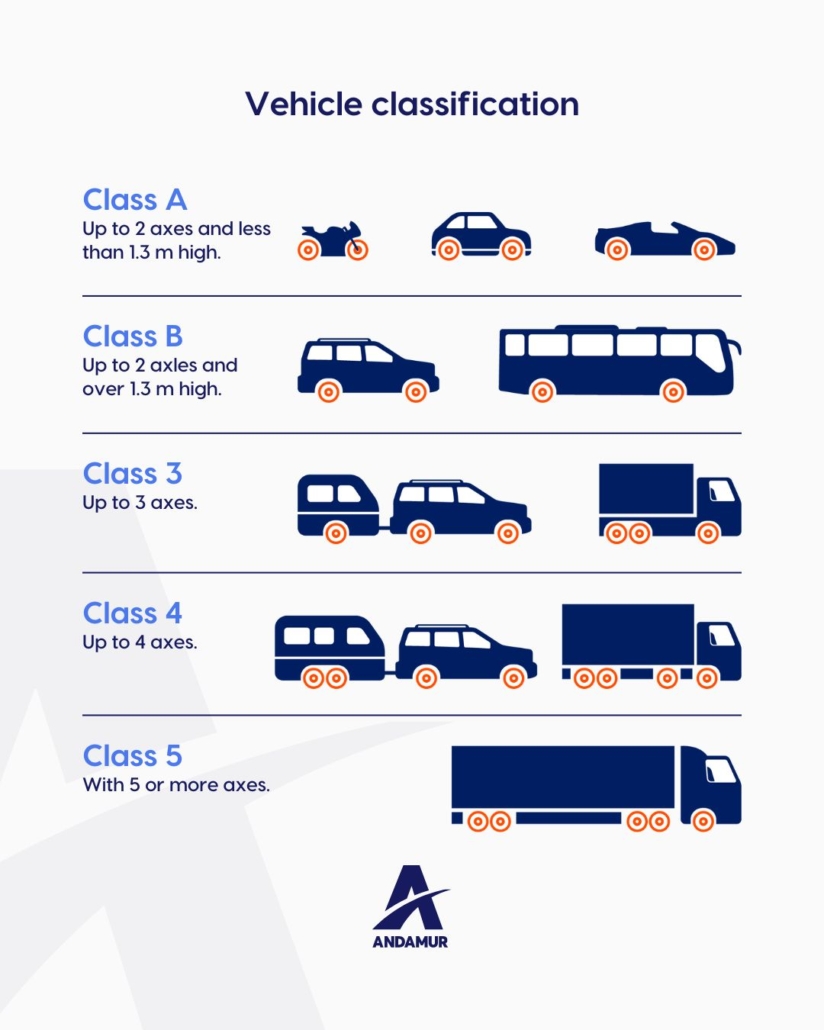
Toll roads in Italy
Italy has an extensive network of toll motorways that covers the entire country, facilitating connections between regions and major cities. Below are some of the main toll roads in Italy:
- Autostrada del Sole (A1)
Known as the “Highway of the Sun”, the A1 is the main road artery in Italy. It crosses the country from north to south, connecting the cities of Milan, Bologna, Florence, Rome and Naples. It is a vital route for the transport of goods between the industrial north and the south of the country.
- Autostrada Adriatica (A14)
Following the east coast of Italy, the A14 connects the northern regions with the center and south of the country. It links important cities such as Bologna, Ancona, Pescara and Bari, facilitating trade along the Adriatic coast.
- Autostrada dei Laghi (A8/A9)
This highway connects Milan with the lake region of northern Italy, passing through cities such as Como and Varese. It provides access to the tourist towns of Lake Maggiore and Lake Como, although its main function for transporters is to connect industrial centres.
- Brenner Autostrada (A22)
The A22 runs through northern Italy, connecting Bolzano with Verona and providing an access route to Austria and Germany via the Brenner Pass. It is a strategic route for the international transportation of goods.
- Autostrada del Mare (A16)
Known as the “Highway of the Sea”, the A16 runs through the Campania region, connecting Naples with the Adriatic coast and passing through cities such as Benevento and Foggia. This route is essential for the transport of goods in southern Italy.
These are just some of the main toll roads in Italy. The network extends throughout the country, providing extensive geographical coverage and facilitating the transportation of people and goods in all directions.
Toll prices in Italy
Toll rates in Italy vary depending on several factors, such as distance traveled, vehicle type and road category. Rates are established to maintain and improve the country’s road infrastructure, as well as to finance road construction and maintenance projects.
Factors affecting toll price
- Distance travelled: The greater the distance travelled, the higher the toll will be.
- Highway Category: Major highways and roads with higher traffic typically have higher rates, especially in metropolitan areas and major commercial routes.
- Vehicle category: In Italy, there are five vehicle categories. On each toll, the rate to be paid is indicated according to the class to which it belongs. This is determined by the height and number of axles.
It is important for carriers to know the applicable rates on the routes they plan to take, as these costs can significantly affect the freight budget. To be informed and updated on rates, you can use a toll calculator in Italy .
How to pay tolls in Italy?
Tolls in Italy can be paid in several ways, providing flexibility for transporters. Here are the main options:
Cash payment
Tolls can be paid in cash at toll booths. However, this option may involve longer wait times, especially during peak hours and high demand periods.
I pay with credit card
Toll booths also accept credit cards. This option is convenient and generally faster than paying in cash.
Electronics devices
For greater convenience and efficiency, electronic toll devices are the preferred option for transporters. These devices are placed on the truck and allow automatic payment of tolls without having to stop.The use of electronic toll devices has multiple benefits for transporters:
- Speed and efficiency : Allows you to go through tolls without stopping, which reduces travel times.
- Reduction of operating costs : Minimizes time lost in queues and reduces fuel consumption.
- Ease of management : Simplifies payment management and offers detailed consumption reports, which facilitates accounting and expense control.
Electronic toll devices for Italy
At Andamur, we have three devices, which are easily installed. You can choose the most suitable one for your case considering the number of vehicles, the type of route you take and the particular needs of the drivers.
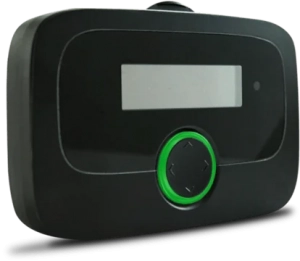
Toll4Europe
You can pay your tolls in Portugal but also in Spain, Italy, Austria, Poland, Denmark Storebælt Bridge, Sweden Øresund Bridge, Germany, Germany Warnowquerung Tunnel, Germany Herrentunnel Tunnel, Bulgaria, Switzerland, Belgium, Belgium Liefkenshoek Tunnel, Slovakia and Hungary. Other features are: possibility of activating and deactivating countries at no additional cost, activation and deactivation of services in 24/48 hours from the request, license plate change allowed and processed between 24 and 48 hours, device blocking allowed by client or by device with a deadline between 24 and 48 for processing, available in 22 languages, a free informative app available, easy installation.
ServiBOX
It covers a total of 16 toll services, in 13 countries: Spain, Portugal, France, Belgium Liefkenshoek Tunnel, Belgium, Italy, Austria, A1 Poland (Gdansk-Torun), A4 Poland (Katowice-Krakow), Poland (Red e- Toll), Denmark Storebælt Bridge, Sweden Øresund Bridge, Norway, Switzerland, Germany and Bulgaria
In addition, it allows you to activate or deactivate countries at no additional cost and is available in 14 languages.
EU Interoperable
It is easy to install, has radio frequency technology and is available for Spain, Portugal, France, Italy, A4 Poland (Katowice-Krakow), A1 Poland (Gdansk-Torun), Austria and Belgium Liefkenshoek Tunnel.
If you don’t know which device is right for your needs, contact us. Our team will help you evaluate your current situation and choose the best option.
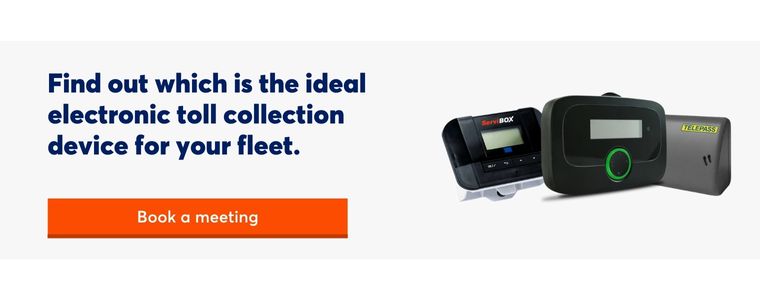
Practical tips for going through tolls in Italy
Device settings
If you have an electronic toll device, remember to activate it correctly when entering Italy. Make sure vehicle characteristics, such as registration, number of axles, and weight, are set correctly to avoid charging errors.
Consumption review
To avoid fines and ensure that payments are made correctly, check the consumption charged to the device when passing through the first toll in Italy. In the most modern units, this review can be done through a mobile application, making it easier to control expenses.
In addition, our clients have access to the Andamur Connect platform, a platform to consult all transits and expenses associated with their accounts.
VAT recovery
Companies and private drivers with tax domicile in member countries of the European Union can recover VAT. In Italy, the standard VAT rate is 21%. Among the deductible expenses, tolls, diesel and lubricants stand out.
Speed limits
- Trucks up to 12 tons: Maximum 100 km/h on highways and highways.
- Trucks over 12 tons: Maximum 80 km/h on highways and highways, 70 km/h on other non-urban roads.
Customer service
If your fleet operates international routes, it is advisable to have a customer service that can resolve queries and problems related to tolls. At Andamur, we offer multilingual assistance 24 hours a day, 7 days a week, to resolve any incident.


